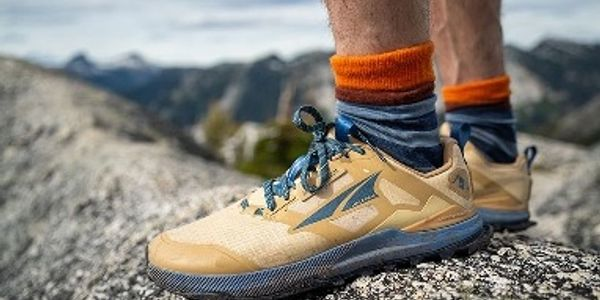Can hiking exoskeletons turn your body into a superhuman e-hiker
By Cap Puckhaber, Reno, Nevada
I’ve been hiking and backpacking for over 15 years, exploring everything from rugged mountain passes to dense forest trails. Through all these experiences, I’ve learned how much gear shapes not just what we do outdoors, but who can do it and how well they do it. Great gear can open new doors. It can extend a day hike into a weekend adventure or bring challenging terrain within reach. But sometimes, physical limits close those doors too soon.
Recently, I came across a technology that feels like it might break through those barriers: powered exoskeletons. These wearable devices help reduce muscle strain and joint load by mechanically assisting your movement. To me, they represent a profound shift in what hiking accessibility could look like.
I’ve witnessed many people struggle on trails I consider straightforward—friends with joint pain, people managing chronic conditions, older hikers trying to keep pace. Powered exoskeletons might just be the tool that helps more people stay on the trail longer and safer. In this post, I’ll share what they are, how they work, who benefits medically, what it’s like to hike with one, and practical advice if you’re curious about trying this tech.
What Is a Powered Exoskeleton and How Does It Work?
Powered exoskeletons are wearable robotic systems that augment human movement. Unlike traditional gear that protects or assists passively—think boots or trekking poles—these devices provide active support through electric motors and sensors.
The core mechanical components include actuators, typically located at the hips, knees, and sometimes the lower back. These motors or pneumatic cylinders provide the physical assistance to help you walk, climb, or carry loads. Embedded sensors track your joint angles, speed, and movement intention in real time, allowing the system to respond instantly and intuitively to your actions. A central control system acts as the brain, processing the data and regulating actuator support to ensure that your motion feels smooth and natural.
A power source, usually a rechargeable lithium-ion battery, fuels the system for anywhere between four to eight hours, depending on the terrain and level of exertion. All of this is held together by a lightweight frame, often built from carbon fiber or aluminum, designed to support your body without limiting mobility.
What does that mean for your hike? Less muscular effort, reduced joint stress, and significantly improved endurance. When you’re climbing a steep hill or hauling a heavy pack, the suit steps in to help lift your legs and stabilize your posture. Some research shows a 30% reduction in the metabolic cost of walking with one of these devices—potentially a game-changer for anyone with mobility concerns.
Medical Conditions That Could Benefit from Exoskeleton Assistance
Although they might seem futuristic, powered exoskeletons already have deep roots in medical rehabilitation and mobility assistance. For instance, people with osteoarthritis, especially in the knees and hips, often struggle with endurance and incline walking. These devices reduce joint load, enabling longer hikes without triggering pain flare-ups.
For those living with Multiple Sclerosis (MS), muscle weakness, balance issues, and coordination problems often limit outdoor activity. Exoskeletons can help by stabilizing gait and improving leg movement. Similarly, individuals with spinal cord injuries (SCI) who retain partial movement may find that exoskeletons offer the leg support and balance needed to regain some hiking ability.
Stroke survivors dealing with hemiparesis or unilateral weakness can use these suits as part of gait retraining and to access uneven outdoor trails more safely. In the case of chronic lower back pain, some models provide lumbar support that alleviates pressure on the back during long walks or when carrying gear.
People affected by peripheral neuropathy, which causes instability and weakness due to nerve damage, can benefit from mechanical assistance to stay upright and balanced. Even age-related conditions like sarcopenia—the natural loss of muscle mass with age—can be mitigated with a suit that reinforces the lower body and helps older adults hike more independently.
In all these cases, powered suits don’t replace strength—they supplement it, helping users go further without risking injury or overexertion.
How Powered Exoskeletons Fit into the Hiking Experience
What does it feel like to actually hit the trail with a powered exoskeleton? While we’re still in the early days of outdoor applications, the user experience is starting to take shape.
Let’s talk about weight and comfort first. Most hiking-appropriate exoskeletons fall in the 15 to 30-pound range. Engineers are working hard to keep the systems lightweight without sacrificing strength, using advanced materials like carbon fiber to keep the burden manageable.
When it comes to terrain, these suits excel on moderate to steep inclines, rocky trails, and stairs. However, they still struggle with highly technical challenges like scrambling over boulders or navigating deep snow. Their battery life usually ranges from four to eight hours—just right for a solid day hike. Some newer models even allow for battery swaps or portable charging, giving you more flexibility on longer outings.
Another surprising benefit? Some exoskeletons redistribute load carrying, shifting the pack’s weight through the frame rather than onto your hips and spine. This reduces overall fatigue and strain, which is huge when you’re hauling water, food, or backcountry gear. Users still retain full mobility and control, but there’s a learning curve. Practicing coordination and balance before venturing into rough terrain is essential.
At the end of the day, hiking with one of these suits isn’t about replacing your natural ability. It’s about amplifying endurance and reducing pain—extending your time on the trail and expanding where you can go.
How to Get a Powered Exoskeleton for Hiking
Right now, powered exoskeletons are expensive and still relatively specialized, but access is improving. If you’re ready to dive in, you can purchase models from established manufacturers like Honda, ReWalk Robotics, Ottobock, or SuitX. Prices vary widely, often starting at $20,000 and reaching up to $100,000 depending on the complexity and use case.
For a lower-commitment option, some rentals are available through physical therapy centers, adaptive sports programs, or outdoor rehabilitation organizations. These can let you test different models on real trails before making a decision. In some cases, insurance and grants—especially when the device is prescribed for medical purposes—can help reduce or cover costs.
You can also explore research and trials at universities and hospitals. These programs are always looking for participants, and in return, you often gain free access to cutting-edge gear and support.
Who Benefits Most and Who Might Not?
Powered exoskeletons can radically improve trail access for some, but they’re not a perfect fit for every hiker or every scenario.
The biggest gains are seen by people with moderate to severe joint pain or muscle weakness. Whether it’s arthritis, past injury, or chronic fatigue, these suits can dramatically reduce pain and make long hikes realistic again. Older adults are another group that stands to benefit greatly. With aging comes balance and strength challenges, and powered support restores some of that lost capacity, boosting confidence and mobility.
Trail maintenance workers often carry heavy tools and supplies through rugged terrain. For them, exoskeletons ease the burden and reduce injury risk, potentially increasing how long they can stay active in the field. Then there are adaptive hikers—those with mobility impairments who have been excluded from many trails. Exoskeletons can open access in a way that was previously unimaginable.
That said, they’re not ideal for everyone. Ultralight hikers will likely be put off by the added bulk and weight. If your goal is minimalism and speed, the exoskeleton might feel like overkill. Likewise, technical climbers or scramblers will find that these devices limit agility and flexibility on steep or exposed routes.
People with severe balance or cognitive impairments may face safety issues when using a powered suit unsupervised. Finally, hikers planning multi-day trips far from power sources may struggle with limited battery life and the need to recharge.
Addressing Concerns: Is Using an Exoskeleton Still Hiking?
There’s definitely a debate out there about whether powered assistance takes away from the spirit of hiking. But to me, that misses the heart of the experience. Hiking isn’t about proving how tough you are. It’s about connection—to nature, to your body, and to the moment.
Gear evolves. People used to scoff at trekking poles or GPS devices, too. Now they’re accepted tools that make hiking safer and more enjoyable. Powered exoskeletons are just another step in that same direction. They’re not a shortcut—they’re an invitation to more people to join the adventure.
Practical Tips for Anyone Considering Powered Exoskeletons for Hiking
If you’re curious about trying one of these suits, I’ve gathered a few practical suggestions. First, try before you buy—seek out rental programs or demo days to find a model that fits your body and hiking style. Definitely consult healthcare providers, especially if you have a chronic condition or mobility limitations, to ensure compatibility and safety.
Train in controlled settings like flat trails or gym environments before heading into uneven or unpredictable terrain. Start with easier trails you know well, gradually progressing to more challenging hikes as you gain confidence. Always plan around battery life, and carry backup power or charging solutions if available.
Think strategically about gear balance, choosing ultralight or modular equipment to counter the added weight of the exoskeleton. And finally, connect with support communities online or in person. There’s a growing network of adaptive athletes and hikers sharing insights, encouragement, and real-world advice.
Why This Matters: Expanding Outdoor Access and Inclusion
We know outdoor recreation boosts both physical and mental well-being. It’s exercise, therapy, social connection, and personal growth all rolled into one. But too many people are still excluded because of physical barriers.
Powered exoskeletons are part of a bigger movement—alongside adaptive gear, trail accessibility efforts, and inclusive design—that’s making the outdoors more welcoming for everyone. Supporting this tech is part of building a trail culture that values equity, creativity, and shared experiences.
Final Thoughts
These devices won’t solve every problem. But powered exoskeletons offer real potential to transform hiking for people who face physical limitations. They extend endurance, reduce pain, and unlock new possibilities.
I’ll be keeping an eye on this space as it evolves. If you or someone you know has been held back by joint pain, fatigue, or mobility challenges, this technology might just change the way you see the trail.
Visit TheHikingAdventures.com to share your story or ask questions. Let’s keep pushing the limits of what’s possible in the great outdoors.
About the author: Cap Puckhaber is a marketing strategist, finance writer, and outdoor enthusiast. He writes across CapPuckhaber.com, TheHikingAdventures.com, SimpleFinanceBlog.com, and BlackDiamondMarketingSolutions.com. Follow him for honest, real-world advice backed by 20+ years of experience.
What is Rucking and Is It Good For You
Best Backpacking Gear Wish List
Hiking and Backpacking Blog Posts

Join our Mailing List
Sign up with us now and be the first one to know about our exclusive offers and product updates.
By submitting your information, you`re giving us permission to email you. You may unsubscribe at any time.
Follow Cap Puckhaber on Social Media


About the Author: Cap Puckhaber
Backpacker, Marketer, Investor, Blogger, Husband, Dog-Dad, Golfer, Snowboarder
Cap Puckhaber is a marketing strategist, finance writer, and outdoor enthusiast from Reno, Nevada. He writes across CapPuckhaber.com, TheHikingAdventures.com, SimpleFinanceBlog.com, and BlackDiamondMarketingSolutions.com.
Follow him for honest, real-world advice backed by 20+ years of experience.





